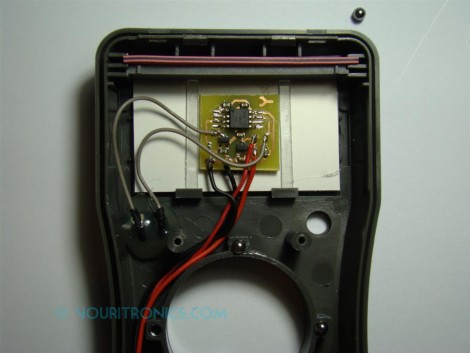
[Florin] picked up a cheap multimeter in order to make multiple measurements at one time. Unfortunately, he wasn’t very good at remembering to turn it off when he was finished so he burned through some batteries. Why an auto-off feature wasn’t the first thing coded into the firmware we’ll never know, but [Florin] developed his own hardware-based auto-off circuit.
It sounds like he had all of the components necessary for this on hand already. He grabbed an AVR ATtiny25 in a surface mount package. To keep the board small, he didn’t include an ISP header, but instead made long pads that could have wires soldered to them for flashing the firmware. The microcontroller drives an NPN transistor that can cut off the ground path between the multimeter and its battery. A tactile switch is connected to one of the external interrupt pins and, when pressed, gives you 15 minutes of time to use the meter. After that, the chip kills the power and goes into sleep mode. Simple, and small enough to fit inside the case.
[via Dangerous Prototypes]















That’s funny, I’d want to do the opposite. Turning meters back on every 15 minutes is quite annoying.
Hah, no kidding Dave, I hear you. I’m always flipping mine off, then flipping it back on.
That said, it’s so weird to not have that sort of feature built into the multimeter. +1 for the fix
Also, nested comments – we has them.
Check your meter’s manual. Holding the hold button when choosing a function (i.e. switching on the meter) on my meter prevents it from auto-shutting off.
This is great! I always forget to turn mine off. i end up having to hook it up to the benchtop power supply.
this has been on my todo list forever (nested comments!)
Wow, great addition! Nested comments FTW! I need to put this in all our multimeters. At the workshop, my dad never remembers to turn them off…
i thought the comments were broken but now i see the light!
A NPN transistor seems like a reasonable fit for this application that has a very low current draw and can tolerate the drop across the transistor. Using P-channel (positive rail) or N-channel (ground rail) transistors is a good way to switch power while minimizing the voltage drop across the transistor.
Having auto-shutoff in my multimeters has saved me so many batteries.
Don’t need a microcontroller though, should have just connected the button to charge up an RC circuit, connected to a comparator which drives the transistor.
Some people do without comparator… however i am not sure about precision of ohmmeter when transistor begins to close slowly…
http://www.edn.com/design/test-and-measurement/4394278/Circuit-automatically-switches-off-DMM
Nested comments? Report links? Reply buttons? Html? HALLELUJAH!
Now we just need a “like” button!
LOL!
“Hackaday reader Brian likes Pilotgeek’s post.”
Where is the Google +1 button?
Superb! The only way I can think to improve it would be to use one of the Tiny’s ADC channels to monitor real measurement activity of the meter, and keep it alive if it’s actively being used. Alternately, the chip could monitor the encoder traces under the selector switch.
I threw together a little circuit like this the other day to inject serial commands directly into a product that was initializing at an unfriendly baudrate (the commands switch it to 9600,8n1 at startup.) Like this circuit, mine was built into the host product itself. Cool to see another parasite design!
I was thinking about adding an accelerometer to my meter. If nothing is registered then shut off after 15 minutes
Plain curiosity: Couldn’t the ATtiny be replaced by a 555, with one or two mods on the circuit?
Maybe but I think that the ATtiny is wired always on and
goes into a low power state. It would depend on how low
the 555 would draw when “off”.
I thought I had gone a long way modding a cheap meter to make it better! At the time I thought about how far you could go – making an analog meter autoranging would be pretty neat!
Like others, I wish I could get my two Metrix MTX328x multimeters to stay on until their rechargable AA cells run down, the auto-off can sometimes be annyoying even when they’re set to half an hour, also the backlight can’t be set for longer than 10 minutes :(
I wonder if it might be possible to have the AVR actually turn itself *off* when the timer runs out (via an external transistor), and have that transistor bootstrapped when the meter is turned on/button pressed.
Not sure about this particular meter, but the 3mA current drawn by this circuit is enough that it might be significant to ‘on’ battery life.
Finally, the main link should go directly to the actual article. The via tag is enough credit when linking another aggregator’s post. Hate having to follow 18 links to get to the actual article…
the 3mA current is for when the tiny25 is active and counting, when counting its done and the meter is turned off the tiny goes into power down mode and it only draws 17.9uA.
Hmmm, I would probably use a PNP in this scenario, but that’s just me. Good PCB, though! Nice hack!
I read this article hoping to find a way to eliminate the annoying automatic shut-off on two of my meters, it’s very annoying.